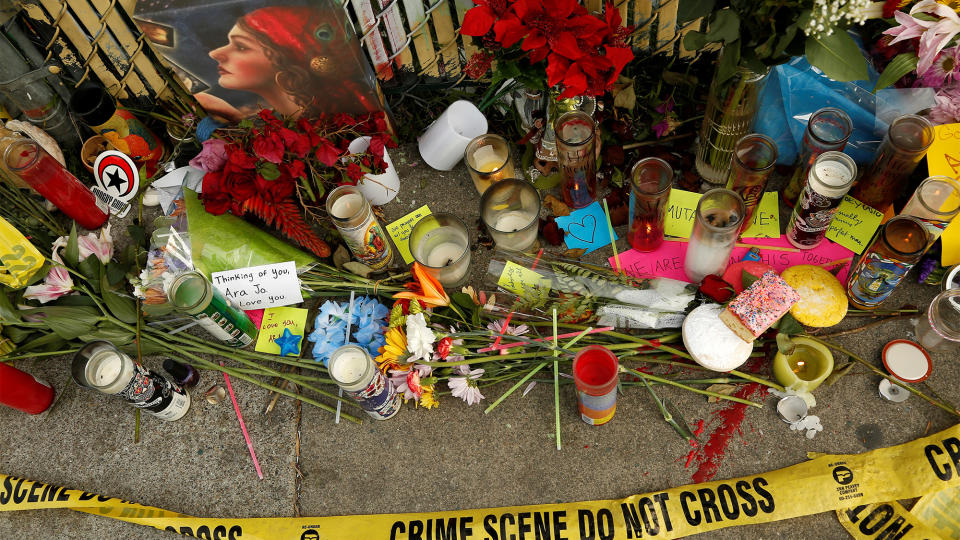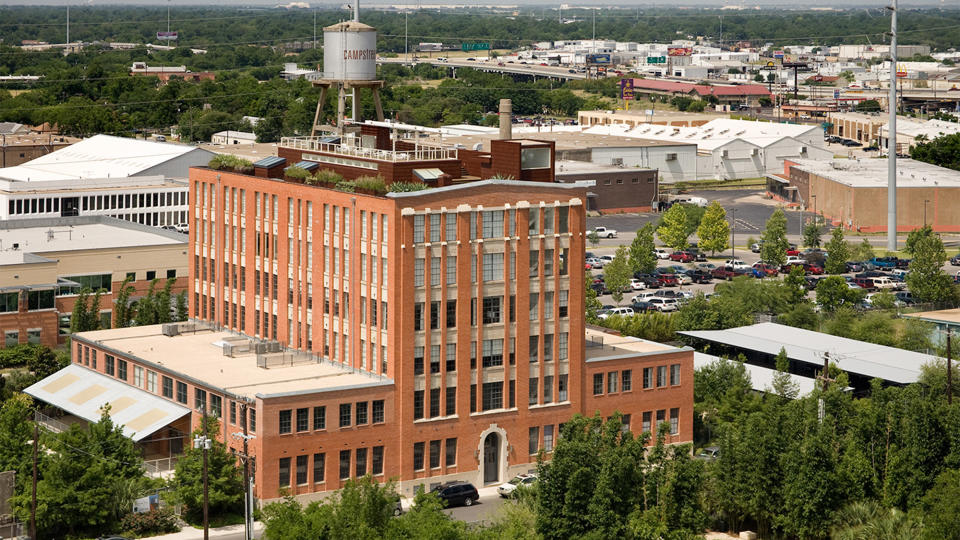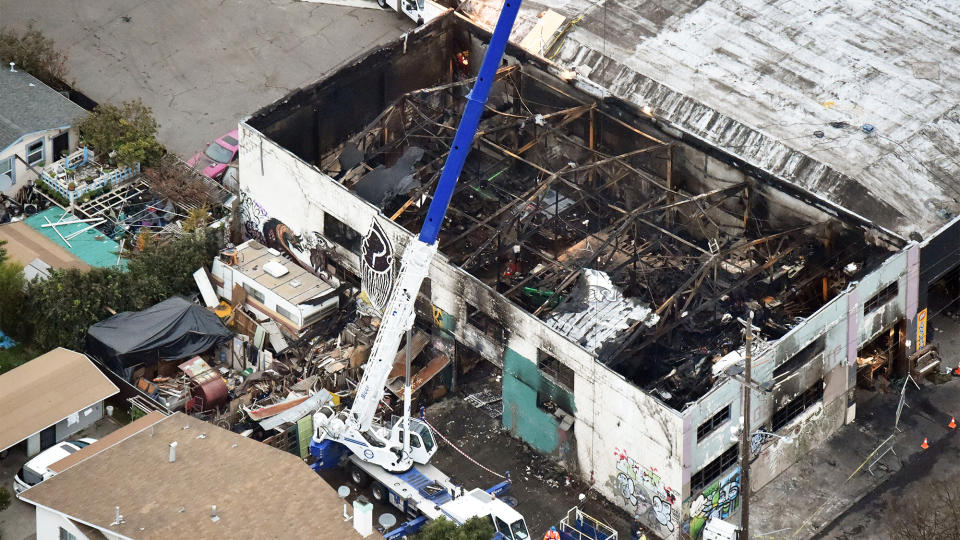Oakland Warehouse Fire Shows Affordable Housing Is a Tinderbox Issue
JOSH EDELSON/AFP/Getty Images
The devastating fire last week at the Ghost Ship, an artists’ warehouse in Oakland, CA—and the tragic loss of three dozen lives as a result—have led to national mourning and a desperate search for answers. The specific cause for the blaze has yet to be determined. But the nightmare event has shed light on a little-known phenomenon, one that is tied directly to America’s housing boom and affordability crisis—and one that officials fear could lead to more disasters.
Ghost Ship was one of the “warehomes” cropping up around the nation: former industrial buildings converted, often illegally, into living, working, and underground performance spaces. They typically don’t adhere to local building and fire codes. And they are usually located in and around the nation’s hottest and most creative cities, the places that draw in young people who can’t afford to live there.
Officials fear that the warehome trend itself, as much as faulty wiring or errant fireproofing, could spark future cataclysms.
There are no official estimates of how many of these converted spaces are scattered through the nation’s most expensive cities. But there are probably at least 100 in the hyper-expensive San Francisco Bay Area alone, say those within the community.

Tayfun Coskun/Anadolu Agency/Getty Images
Unfortunately, such spaces are the only option that many of the artists believe they can afford if they want to remain in their cities of choice. In Oakland, rental studios go for a median $1,550 a month and one-bedrooms were leasing for $2,000 a month as of Dec. 1, according to Apartment List. Meanwhile, the median home price in Oakland is $547,000, according to realtor.com®.
But artists, often living off sporadic meager paychecks, may be risking their lives for cheap rent, cool performance spaces, and a sense of creative community.
“If you grew up in safe little residential spaces never thinking about fires and then in your 20s you decide to move to a cool new warehome, you might just assume it’s safe,” says Gui Cavalcanti, founder of the legal artists’ workspace Artisan’s Asylum, located outside of Boston. “But the fact is these converted industrial spaces aren’t designed for residential use.”
The appeal of ‘warehome’ living: A vast and cheap creative space
Living in a warehome was a decision made out of necessity for Jose Avalos, 38, one of the roughly 20 to 25 residents of the 10,000-square-foot Ghost Ship. On the night of the blaze, roughly 100 people filled the building for a party. Avalos escaped the flames with his two dogs and his life. His next-door neighbor was not as fortunate.
“It was the only place that would take me. It didn’t matter that I had dogs and all my art supplies,” says Avalos. “These places exist all over the Bay Area. They are the only places that some of us can go.”

gofundme.com
The cabinetmaker from Southern California moved into a live/work studio in the warehome a little over two years ago. He paid $575 a month in rent and $40 a month for internet and trash pickup. He doesn’t earn enough to pay much more in rent. Some units had kitchens. His did not.
The residents shared two bathrooms on the first floor and another two on the second floor. There were also communal kitchens and living rooms on both floors. He believes the fire began in the upstairs living room, which doubled as a performance space.
His neighbors were a mix of jewelry makers, computer coders, musicians, and painters who collaborated with one another and helped each other find work.
“Everybody in there was my family,” says Avalos.
The building was not permitted for residents or performances, and the city had started an investigation on the building’s illegal construction before the fire broke out. A city inspector visited the Ghost Ship on Nov. 17 but couldn’t gain entry.
Warehomes are often appealing to many residents for their large footprint as much as for their bargain-basement rents.
One artist living and working in a Bay Area warehome, who requested anonymity, says the space itself has been the primary lure. The high ceilings where the 26-year-old circus performer lives have allowed her to practice aerial acts in her own home.
“Having space held to experiment, play, design, and celebrate together is vital to creative development,” says the artist, who also has a day job as a mechanical engineer. “We need affordable places, yes, but we also need community and space to assemble.”
In exchange, she pays $1,250 a month for a room in the building she shares with 16 fellow creatives. Her rent includes utilities and house supplies. The group also holds performances—underground ones, not sanctioned by the city. (She was quick to point out there are fire alarms and extinguishers in each room as well as fire escape ladders on the second floor and glow-in-the-dark exit signs. Incense and candles are prohibited.)
Now, with her engineer’s salary, she could afford to move into an above-board residence. But she doesn’t want to. And neither do most of her neighbors.

artspace.org
“Artists are drawn to warehouses and buildings like that because of the natural light, high ceilings, big windows, [and] durable surfaces” in which they can create large-scale projects, says Melodie Bahan, a spokeswoman for Artspace, a national nonprofit real estate developer for artists and arts groups based in Minneapolis. The organization has finished 42 projects, the majority of which are warehouses converted into (legal) live/work spaces, and has a dozen more in development.
What would it cost to bring warehomes up to code? A lot
Converting an old industrial building into a residential building up to current city safety standards is a very pricey proposition—and may cost just as much as constructing a new building, says Jim Poteet, a San Antonio–based architect who has turned both a former candy factory and previous glass factory into high-end condos. He declined to provide estimates as costs vary widely by building and city.
Many former warehouses aren’t up to current industrial codes because they were built before the regulations were implemented or updated, he says.
To transform them into safe and legal housing, new stairwells and exits typically have to be added; aging handrails need to be replaced; and new or expanded sprinkler systems need to be installed. Modern and city-approved electrical systems and plumbing need to be added to each unit.
“There are so many things in an old building that would need to be addressed,” Poteet says. “The [artists] who are occupying the buildings now wouldn’t be able to reside there” because they couldn’t afford them once the costly renovations are made.

Chris Cooper
The folks who are converting warehouses into performance/living/work spaces often don’t understand building codes—or simply don’t have the cash to meet local standards, says Cavalcanti, the workspace entrepreneur who left Boston and now lives in the Bay Area. Many of his friends live in warehomes.
There is certainly no shortage of long-shuttered, vacant industrial buildings on the outskirts of America’s top cities—and landlords willing to look the other way when potential tenants come knocking, he says. Those tenants can then subdivide the building into a series of rooms, dorm-style, with communal kitchens and a living room that can double as a performance space.
Adding to the warehome danger: Tenants don’t always welcome city inspectors with open arms.
“They see fire marshals and building inspectors not as people who could potentially help them or keep them safe, but as people who could evict them from their home,” Cavalcanti says.
In the wake of the Ghost Ship fire, many Bay Area artists are now worried that their cities will shutter their illegal warehomes instead of helping them affordably bring them up to code. That will leave many of them homeless.
“Displacing everybody is the worst thing they can do,” says former Ghost Ship tenant Avalos. “Even if there’s more affordable housing, these places are not going to go away. … People need these places to release their passions. You can’t do that in your studio apartment.”
That’s a challenge for the Bay Area and the rest of the county’s priciest metros.
“The sanctity of life needs to be our highest priority, [but] we do not want to take measures to eradicate the artists’ communities of Oakland,” Erica Terry Derryck, a spokeswoman for Oakland Mayor Libby Schaaf tells realtor.com. “We want to be able to find a path forward that protects our residents and protects our artists’ communities. It will be a tall order, but we are focused on being able to do both.”
The first steps toward making top cities more affordable
Oakland, plagued by poverty and crime for decades, wasn’t always so expensive. That made it especially appealing for artists. But as the tech boom led prices to reach mind-boggling heights in the Bay Area, the city has largely gentrified.
And “unlike San Francisco, where there’s been a building boom in recent years, there haven’t been very many housing units built in Oakland,” says Sarah Karlinsky, a senior policy adviser at SPUR, an urban planning think tank based in San Francisco.
In the summer of 2015, the Mayor’s Artist Housing and Workspace Task Force was created to seek recommendations on how to address what’s reaching crisis proportions.
And last month, voters in Oakland and encompassing Alameda County approved measures to earmark millions of dollars for the creation of new affordable housing.
Since the tragedy, the Oakland mayor announced that $1.7 million in philanthropic funds would go toward supporting sustainable solutions for creating more affordable—and safe—housing for Oakland artists.
“Oakland used to be known as a place where people could live relatively affordably compared to San Francisco,” says Gloria Bruce, executive director of the East Bay Housing Organizations, an Oakland-based umbrella association for local affordable housing groups. “We really just need to have more housing that’s affordable and housing that’s safe.”
The post Oakland Warehouse Fire Shows Affordable Housing Is a Tinderbox Issue appeared first on Real Estate News and Advice - realtor.com.

 Yahoo Finance
Yahoo Finance 

